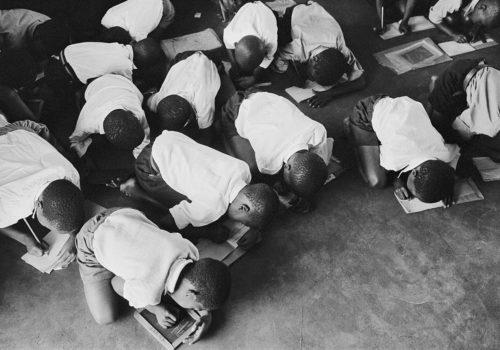The Deutsche Börse Photography Foundation presents South African photographer Ernest Cole’s oeuvre with the exhibition “Ernest Cole. House of Bondage” at The Cube, Eschborn.
An important chronicler of apartheid politics, it is the first major exhibition of his works in Germany. In around 130 photographs, it covers all 15 thematic chapters of his eponymous book, “House of Bondage”, and also includes works from the chapter “Black Ingenuity”, which was not published in the original edition. The presentation is complemented by early original prints, personal documents of the artist, original editions of published series of images in magazines and a filmed interview with Cole from 1969.
Ernest Cole (1940-1990) chronicled the Black majority’s experience during apartheid in South Africa as forcefully and comprehensively as few of his contemporaries. In his photobook “House of Bondage”, published in 1967, he captured countless forms of violence and repression, which, as a Black photographer, he was also subject to. He started working as a photographer at the age of 18, aiming to draw global attention to the grievances of his home country. Being classified as “Coloured” allowed Cole freedom of movement and access to various places which the authoritarian regime would not have granted him as a “Black” person. Cole photographed the precarious living conditions of mine labourers and domestic workers in white households, as well as the miserable state of the transport and health sectors. He paid particularly close attention to the children and young people, who, denied proper education, lived in poverty and despair. As a person directly affected, his insights into the life of Black South Africans in the 1960s are harrowing – marked by oppression, arbitrary police action and expropriation.
In 1966, Cole managed to leave South Africa, secretly getting all his negatives out of the country ahead of his own departure. Fully aware that he would never be allowed to return to his home country once published, he released his photographs in the illustrated book “House of Bondage” in the US in 1967, displaying the horrors of the apartheid system to the entire world in 15 thematic chapters, each accompanied by his own texts. It would, however, take decades for the political situation of Black South Africans to improve. In February 1990, Ernest Cole died just months before this change was heralded, in exile in New York City. At the time of his death, he felt disillusioned by the limited power of his images. Today, “House of Bondage” is considered one of the most important photobooks of the 20th century.
The exhibition “Ernest Cole. House of Bondage” is a cooperation with Magnum Photos. It was curated by Anne-Marie Beckmann, Deutsche Börse Photography Foundation, and Andréa Holzherr, Magnum Photos.
About the artist
Ernest Cole was born as Ernest Levi Tsoloane Kole in 1940 in Eesterust township near Pretoria. He discovered his passion for photography at the age of eight and started taking pictures just a few years later. In 1958, he started working as an assistant to German photographer Jürgen Schadeberg and later as a photographer for the magazine “Drum”, one of the most influential publications for Black readers in South Africa. After further employment with “Zonk!” and “Bantu World”, the largest African daily newspaper in Johannesburg, Cole worked as a freelance photographer from 1961. Many of the photographs taken during this time were later published in “House of Bondage”. In 1966, he managed to leave the country for London and then Paris, finally settling in New York City in September. With the support of the Magnum Photos agency, his book “House of Bondage” was published in the US one year later. It is a comprehensive and systematic documentation of the effects of the South African apartheid regime in the early 1960s on the country’s Black population. In the following decades, he alternately lived in Sweden and New York City, but was hardly active as a photographer. Ernest Cole died in New York City in 1990 at the age of 49.
The photobook “House of Bondage”
“House of Bondage” was published in 1967 by Ridge Press in New York City. The extensive photobook features Ernest Cole’s haunting 1960s photographs which document the repressive apartheid legislation and everyday life of Black South Africans.
“House of Bondage” is structured in 15 thematic chapters with titles such as “The Mines”, “For Whites Only” or “Heirs of Poverty”, with photographs taken and selected by Cole, as well as detailed accompanying texts with his personal insights into the reality of life under the apartheid system. “House of Bondage” was reissued in 2022 by Aperture Publishing. The chapter “Black Ingenuity” was added to the new edition, which Cole had selected images for but did not ultimately include in the original 1967 publication. In addition to the original texts by Cole, “House of Bondage” also includes articles by Mongane Wally Serote, Oluremi C. Onabanjo and James Sanders, an “Ernest Cole Family Trust” representative.
English edition 232 pages, 227 images, 21×29 cm, Hardcover, ISBN: 9781597115339.
Ernest Cole. House of Bondage
June 2 to September 17, 2023
The Cube
Mergenthalerallee 61
65760 Eschborn, Germany
















